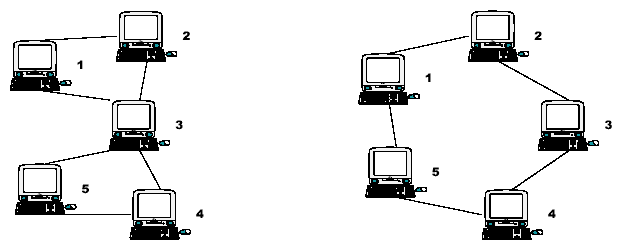【POJ】1523 SPF(割点)
http://poj.org/problem?id=1523
太弱。。。
too weak。。
割点我都还要看书和看题解来写。。果然是写不出么。。
割点就那样求,然后分量直接这个节点有多少子树就有子树个数+1个分量。还要注意root的特判。。sigh。。就是崩这里了。
#include <cstdio>
#include <cstring>
#include <cmath>
#include <string>
#include <iostream>
#include <algorithm>
#include <queue>
using namespace std;
#define rep(i, n) for(int i=0; i<(n); ++i)
#define for1(i,a,n) for(int i=(a);i<=(n);++i)
#define for2(i,a,n) for(int i=(a);i<(n);++i)
#define for3(i,a,n) for(int i=(a);i>=(n);--i)
#define for4(i,a,n) for(int i=(a);i>(n);--i)
#define CC(i,a) memset(i,a,sizeof(i))
#define read(a) a=getint()
#define print(a) printf("%d", a)
#define dbg(x) cout << (#x) << " = " << (x) << endl
#define printarr2(a, b, c) for1(_, 1, b) { for1(__, 1, c) cout << a[_][__]; cout << endl; }
#define printarr1(a, b) for1(_, 1, b) cout << a[_] << '\t'; cout << endl
inline const int getint() { int r=0, k=1; char c=getchar(); for(; c<'0'||c>'9'; c=getchar()) if(c=='-') k=-1; for(; c>='0'&&c<='9'; c=getchar()) r=r*10+c-'0'; return k*r; }
inline const int max(const int &a, const int &b) { return a>b?a:b; }
inline const int min(const int &a, const int &b) { return a<b?a:b; }
const int N=2005;
int ihead[N], cnt, rt, iscut[N], FF[N], LL[N], fa[N], tot;
struct ED { int to, next; }e[N*N];
void add(int u, int v) {
e[++cnt].next=ihead[u]; ihead[u]=cnt; e[cnt].to=v;
e[++cnt].next=ihead[v]; ihead[v]=cnt; e[cnt].to=u;
}
void tarjan(int u, int fa) {
FF[u]=LL[u]=++tot;
int child=0;
for(int i=ihead[u]; i; i=e[i].next) {
int v=e[i].to;
if(!FF[v]) {
tarjan(v, u);
++child;
if(LL[v]>=FF[u]) ++iscut[u]; //dbg(iscut[u]); dbg(u);
LL[u]=min(LL[v], LL[u]);
}
else if(FF[v]<FF[u] && fa!=v) LL[u]=min(LL[u], FF[v]);
}
if(child==1 && fa==-1) iscut[u]=0;
else if(child>1 && fa==-1) iscut[u]=child-1; //特判
}
int main() {
int u, v, cs=0;
while(1) {
u=getint(); if(u==0) break;
v=getint();
CC(ihead, 0); CC(iscut, 0); cnt=tot=0; CC(FF, 0); CC(LL, 0);
++cs;
add(u, v); rt=max(rt, v);
while(1) {
u=getint(); if(u==0) break;
v=getint();
add(u, v); rt=max(rt, v);
}
for1(i, 1, rt) if(ihead[i] && !FF[i]) tarjan(i, -1);
// for1(i, 1, rt) if(hav[i] && iscut[i]) printf("%d\n", i);
int flag=0;
printf("Network #%d\n", cs);
for1(i, 1, rt) if(iscut[i]) printf(" SPF node %d leaves %d subnets\n", i, iscut[i]+1), flag=1;
if(!flag) puts(" No SPF nodes");
puts("");
}
return 0;
}
Description
Consider the two networks shown below. Assuming that data moves around these networks only between directly connected nodes on a peer-to-peer basis, a failure of a single node, 3, in the network on the left would prevent some of the still available nodes from communicating with each other. Nodes 1 and 2 could still communicate with each other as could nodes 4 and 5, but communication between any other pairs of nodes would no longer be possible.
Node 3 is therefore a Single Point of Failure (SPF) for this network. Strictly, an SPF will be defined as any node that, if unavailable, would prevent at least one pair of available nodes from being able to communicate on what was previously a fully connected network. Note that the network on the right has no such node; there is no SPF in the network. At least two machines must fail before there are any pairs of available nodes which cannot communicate.

Node 3 is therefore a Single Point of Failure (SPF) for this network. Strictly, an SPF will be defined as any node that, if unavailable, would prevent at least one pair of available nodes from being able to communicate on what was previously a fully connected network. Note that the network on the right has no such node; there is no SPF in the network. At least two machines must fail before there are any pairs of available nodes which cannot communicate.

Input
The
input will contain the description of several networks. A network
description will consist of pairs of integers, one pair per line, that
identify connected nodes. Ordering of the pairs is irrelevant; 1 2 and 2
1 specify the same connection. All node numbers will range from 1 to
1000. A line containing a single zero ends the list of connected nodes.
An empty network description flags the end of the input. Blank lines in
the input file should be ignored.
Output
For each network in the input, you will output its number in the file, followed by a list of any SPF nodes that exist.
The first network in the file should be identified as "Network #1", the second as "Network #2", etc. For each SPF node, output a line, formatted as shown in the examples below, that identifies the node and the number of fully connected subnets that remain when that node fails. If the network has no SPF nodes, simply output the text "No SPF nodes" instead of a list of SPF nodes.
The first network in the file should be identified as "Network #1", the second as "Network #2", etc. For each SPF node, output a line, formatted as shown in the examples below, that identifies the node and the number of fully connected subnets that remain when that node fails. If the network has no SPF nodes, simply output the text "No SPF nodes" instead of a list of SPF nodes.
Sample Input
1 2 5 4 3 1 3 2 3 4 3 5 0 1 2 2 3 3 4 4 5 5 1 0 1 2 2 3 3 4 4 6 6 3 2 5 5 1 0 0
Sample Output
Network #1 SPF node 3 leaves 2 subnets Network #2 No SPF nodes Network #3 SPF node 2 leaves 2 subnets SPF node 3 leaves 2 subnets
Source
博客地址:www.cnblogs.com/iwtwiioi 本文为博主原创文章,未经博主允许不得转载。一经发现,必将追究法律责任。

